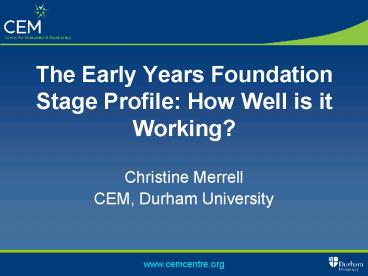The Early Years Foundation Stage Profile: How Well is it Working - PowerPoint PPT Presentation
1 / 19
Title:
The Early Years Foundation Stage Profile: How Well is it Working
Description:
Girls achieve at a higher level than boys. www.cemcentre.org ... Suggest that using PIPS is beneficial. Is the Foundation Stage Profile fit for purpose? ... – PowerPoint PPT presentation
Number of Views:197
Avg rating:3.0/5.0
Title: The Early Years Foundation Stage Profile: How Well is it Working
1
The Early Years Foundation Stage Profile How
Well is it Working?
- Christine Merrell
- CEM, Durham University
2
- Background
- Is the EYFSP reliable?
- Does it fulfil its primary purpose?
- Impact of using reliable objective assessment
3
Background
- 1998
- On-entry Baseline Assessment became a statutory
requirement - 2003
- Foundation Stage Profile
- Emphasis on observing childrens behaviour
- 2008
- Early Years Foundation Stage Profile
- Stronger steer on assessment through observation
4
Reliability
- Observation of children participating in
- everyday activities is the most reliable way
- to build up an accurate picture of what
- children know, understand, feel, are
- interested in and can do.
- (EYFSP Handbook, 2008)
- Where is the evidence for this?
5
Reliability
- Is all development observable from
child-initiated activities? - Failed to find figures for reliability or
predictive validity
6
Primary Purpose
- The primary purpose of the EYFS profile is to
- provide year 1 teachers with reliable and
- accurate information about each childs level of
- development as they reach the end of the
- EYFS, enabling the teacher to plan an effective,
- responsive and appropriate curriculum that will
- meet all childrens needs.
7
Statistical First Release,2008
- Majority of children work securely within (6
points or more) the Early Learning Goals for all
assessment areas. - Area with the highest percentage of children
working securely was Physical Development (89) - Lowest was Communication, Language and Literacy
Writing (61) - Girls achieve at a higher level than boys.
8
Distributions of EYFS scores
9
Distributions of EYFS scores
10
Distributions of EYFS scores
11
Distributions of EYFS scores
12
- Does Objective, Reliable On-Entry Baseline
Assessment Improve Key Stage 1 Results?
13
PIPS On-Entry Baseline Assessment
- First developed in 1994
- Now used in
- England
- Scotland
- Wales
- Australia
- New Zealand
- Netherlands
- Germany
- South Africa
- Hong Kong
- International Schools
14
- Computer-adaptive
- Assesses
- Early reading and vocabulary
- Phonological Awareness
- Early maths
- Personal, social and emotional development
- Short-term memory
- Test/Retest Reliability 0.98
- Good Predictive Validity
15
- National end of Key Stage 1 SATs data for 2000/01
2006/07 academic years for state schools - Selected 2 groups
- Non PIPS Users
- PIPS Users
16
PIPS Users
- 531 schools (approx 18,000 pupils per year)
- Used PIPS continuously between 1996/97 and
2002/03 then stopped when FSP was made statutory - 2002/03 cohort took KS1 SATs in 2005
17
Analysis
- KS1 levels for each subject converted into point
scores - Then standardised mean 0 and SD 1 within
each year and subject - Used teacher-given results
18
Results
19
Conclusions
- Conclusions from analysis have to be tentative
- Interesting trends over time
- Suggest that using PIPS is beneficial
- Is the Foundation Stage Profile fit for purpose?































